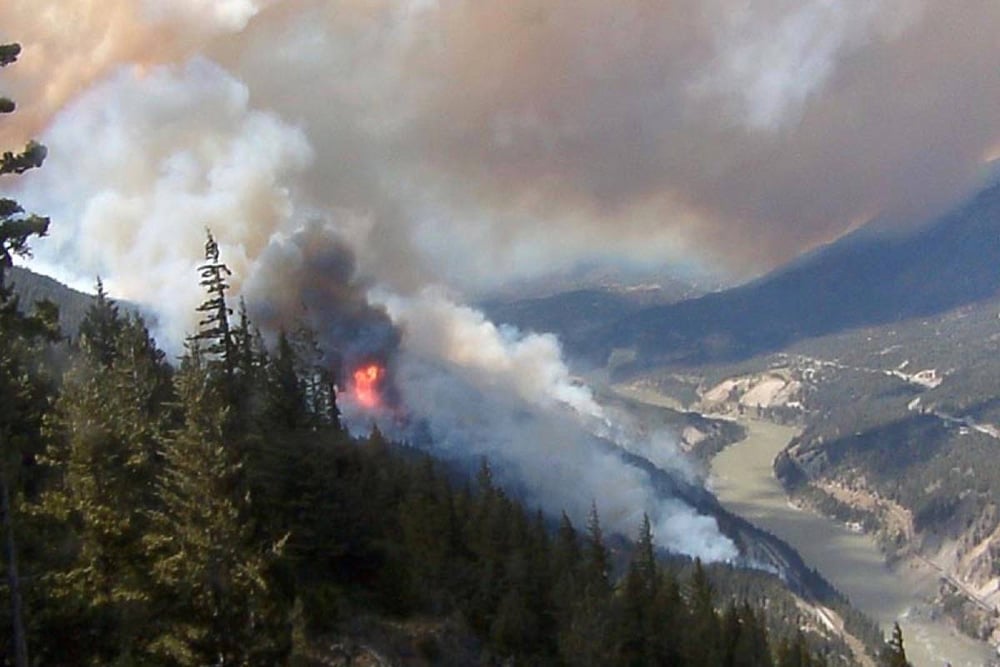Ryan Marander was driving from his home in Burnaby to a friend’s cabin at Mcleese Lake on June 30 when he noticed something was wrong. “Before we even got to the train, we saw some black smoke coming up from something into the sky,” he says.
It was about 3:30 p.m. or shortly after and there didn’t appear to be any other fires in the area, he says. But as they drove north on Highway 1 as it passed above the Fraser Canyon and the town of Lytton, they could see a train had stopped on the tracks. The cars appeared to be carrying lumber wrapped in white plastic.
“And under one of these cars, there was a fire,” Marander says, adding that the flames appeared to be coming from a trestle bridge beneath the cars. “We slowed down a bit and saw that the fire had been noticed, and we kept going.”
Hours later, as they approached their destination north of Williams Lake, Marander would hear media reports that the tiny community of Lytton, population 250, had burned shortly after they passed through. The blaze that tore through the region claimed the lives of two people and destroyed 90 per cent of the town. Two weeks later, the Lytton Creek fire has burned nearly 9,000 hectares and continued to burn out of control Tuesday.
“Of course, I can’t tie two and two together, but you can definitely make assumptions,” Marander says. Others travelling through the area at the same time have reported similar sightings.
The official cause of the Lytton Creek fire is still under investigation. On Friday, the Transportation Safety Board of Canada said it was deploying an investigation team, “following a fire potentially involving a freight train in Lytton, British Columbia.”
According to the board, the number of train-related fires in Canada is growing. Its 2019 report on rail transportation occurrences blames an overall increase in railway accidents on “the unusually high number of right-of-way fires” reported that year, with fires increasing fivefold over a 10-year period.
As rail traffic through the province increases and summers become hotter and drier, it’s unlikely that the risk of train-ignited rail fires will diminish.
Kira Hoffman is a fire ecologist and postdoctoral fellow at the University of British Columbia and the Bulkley Valley Research Centre who compiled data from the National Forestry Database showing wildfire ignitions by source in B.C. between 1990 and 2019. They show that railways are responsible for less than one per cent of total wildfires.
“But it’s their location that makes these ignitions hazardous as they often run right through the heart of remote and forested communities,” adds Hoffman, whose research focuses on reconstructing historic fire activity and understanding how climate change contributes to more unpredictable and harder-to-control wildfires.
CN senior media relations advisor Mathieu Gaudreault did not provide a response to The Tyee’s questions about whether a passing train may have sparked the Lytton Creek fire.
However in an emailed statement, he said the company had investigated social media posts showing the train fire that Marander may have seen. CN concluded the train, which originated in Prince Rupert and was bound for Vancouver, passed “uneventfully” through Lytton earlier in the afternoon and was stopped on the tracks in Boston Bar, about 45 kilometres south of Lytton, about the time Marander passed through.
“At the moment the video was taken, the train was stationary, near a fire already burning on an embankment in Boston Bar,” he said. A tarp covering the train’s cargo was later discovered to have melted, but “at no time was the train or its cargo ablaze.”
In an update posted Monday, the RCMP said it is working with BC Wildfire Service to investigate two separate “areas of interest” near both Lytton and Boston Bar where the fire may have started. It said investigators are focusing on an area at the south end of Lytton that provides access to a foot and rail bridge across the Fraser River.
“The investigation is looking at all movements and actions of any individuals, vehicle traffic and a southbound freight train that were all in the area around 4:30 p.m.,” it said.
Rachel Reimer has experience fighting wildfires in the Lytton area and believes trains are a likely culprit in the recent fire. She is currently doing research with the United States Forest Service about inclusivity in wildfire and other mountain professions.
As a former initial attack crew leader with BC Wildfire Service, part of Reimer’s job was to identify where a wildfire started and protect the area for investigators. After five seasons spent fighting wildfires in the Lytton area, two of them stationed within the town itself, she says the region offers the perfect storm for train-ignited wildfires.
“Given my experience in Lytton, it’s not surprising to me that it could have been a rail start,” she says. “Common sense dictates when you are called to a wildfire and it’s started beside the train tracks and there’s no road access, likely it was a train that caused that fire.”
Three ingredients are needed to start a fire, Reimer says: fuel, heat and oxygen.
In Lytton, the railway travels across the canyon slope, with the river below and community above. The hills are lined with standing dry grass and sage, blanketed in a highly flammable carpet of ponderosa pine needles. The combination creates a fuel that is “well suited to starting a fire and sustaining a quick initial spread of the fire,” Reimer says.
The extreme heat in Lytton in the days before the fire have been well-documented.
The town broke Canadian temperature records three days running. On the third day, June 29, it recorded an all-time high of 49.6 C.
Add to that the strong, southerly winds that blow through the Fraser Canyon, at times reaching 80 kilometres an hour, and current conditions in the region provide a recipe for disaster, Reimer says.
“If anything starts from the railway or the highway typically the most aggressive spread will be uphill,” she adds, putting the community directly in the fire’s path.
Routine rail traffic is all it takes to provide the spark that can ignite a fire, Reimer says. Work like rail cutting or grinding, a method of maintaining the tracks, is listed as a “high risk activity” under B.C.’s Wildfire Regulation, she says.
According to a Forest Appeals Commission decision from last year, the local wildfire risk was rated “extreme” when rail cutting by CN created the spark that ignited the Cisco Road fire 10 kilometres south of Lytton on June 11, 2015. It’s one of many Reimer says she attended that started adjacent to railway tracks.
The costs incurred would be among the largest of any wildfire in Canada.
The blaze spread quickly due to strong winds, dry fuel and steep slopes, the commission said in its decision. BC Wildfire Service fought the fire for nearly three months, wrapping up in early September. It wasn’t considered fully extinguished until October.
CN was initially ordered to pay just over $16 million for its role in the Cisco Road fire. The figure included $9 million in lost mature timber and other natural resources, government expenses of $7 million and a $75,000 administrative fee.
CN appealed the penalty. It backfired.
Not only did the commission deny CN’s appeal, it increased the amount it was ordered to pay by nearly $350,000. In total, CN was charged more than $16.6 million for the Cisco Road fire.
It’s unclear how many cost-recovery orders have been issued for wildfires caused by people and industry since the Wildfire Act came into effect in 2005. The orders themselves are not made public unless they are appealed to the Forest Appeals Commission.
In total, CN has appealed four wildfire compensation orders, accounting for about 10 per cent of all wildfire-related appeals to the commission.
In 2011, the commission agreed with CN that it was inappropriate to fine it twice for a single incident — a dragging brake that dropped “hot metal fragments” along the tracks — that caused two separate fires near Ashcroft, B.C., in 2005. As a result, fines for one of the fires, known simply as Fire 136, were dropped.
The commission also reduced the penalty for the associated Fire 135 based on CN’s calculation of the timber values it decimated.
In 2017, the commission reduced the amount owing for a 2014 fire near Williams Lake that burned 171 hectares designated as a mule deer winter habitat and old-growth management area. Compensation was reduced from $320,000 to $203,000 when the commission determined that CN could not be charged for both the timber and grassland values on the same land.
Ryan Morasiewicz is a Vancouver-based lawyer whose practice focuses on commercial and insurance defence litigation.
He says there are two sections under the Wildfire Act that allow the province to recoup costs. Section 25 applies to landowners and lease holders who ignite fires; it does not allow defendants to argue due diligence — they are responsible for any fires regardless of steps taken to prevent them.
“It doesn’t matter if the person or the business involved at the actual site exercised due diligence and had proper fire breaks and had all the proper firefighting equipment nearby and just by bad luck it didn’t work,” he says.
Sections 26 and 27 are aimed at those who deliberately violate the act — the camper who lights a bonfire during a fire ban or the driver who throws a lit cigarette out a car window.
While Section 25 tends to apply to industrial activities, in the case of CN’s Cisco Road fire, the company was held responsible under Sections 26 and 27. At first blush, the Lytton Creek fire appears remarkably similar, Morasiewicz says.
“It’s basically almost identical to the situation,” he says, adding that how the province proceeds will depend on investigation results.
He adds that litigation under the Wildfire Act is “a very narrow and esoteric area” given that, up until the past decade, it was relatively rare.
“Considering the way things have developed over the last few years in terms of the forest fire season — especially this year — I would not be surprised if there was going to be a lot more attention paid by both the government and by people in general to these remedies,” he says.
CP Rail, which also operates trains in the Lytton area, said in an email to The Tyee that it is co-operating with the investigators and added that rail crews closely monitor the right-of-way for signs of wildfire.
“If spotted, any indication of a wildfire is immediately relayed to authorities for investigation,” CP spokesperson Salem Woodrow said. “CP increases regular inspections of our tracks and other equipment during periods of extreme weather.”
CN’s Gaudreault said the company follows strict regulations and protocols during dry conditions, including inspecting trains for mechanical issues, equipping field crews with fire suppression equipment, monitoring trains for sparks and clearing vegetation along the right-of-way to minimize fire risk.
“Moreover, we are increasing substantially patrols that precede and follow trains to inspect for any potential issues on the track ahead and for any sign of fire after train passage,” Gaudreault said. “Those patrols are equipped with fire suppression equipment.” ![]()
Read more: Environment
















Tyee Commenting Guidelines
Comments that violate guidelines risk being deleted, and violations may result in a temporary or permanent user ban. Maintain the spirit of good conversation to stay in the discussion.
*Please note The Tyee is not a forum for spreading misinformation about COVID-19, denying its existence or minimizing its risk to public health.
Do:
Do not: